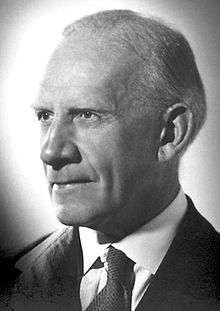Robert Robinson (organic chemist)
| Sir Robert Robinson OM PRS FRSE | |
|---|---|
 | |
| President of the Royal Society | |
|
In office 1945–1950 | |
| Preceded by | Sir Henry Harrett Dale |
| Succeeded by | Edgar Adrian |
| Personal details | |
| Born |
13 September 1886 Derbyshire, England |
| Died |
8 February 1975 (aged 88) Great Missenden, Buckinghamshire, England |
| Citizenship | United Kingdom |
| Nationality | English |
|
Scientific career | |
| Fields | Organic chemistry[1] |
| Institutions |
University of Sydney University of Liverpool British Dyestuffs Corporation University of Manchester University of London University of Oxford |
| Alma mater | University of Manchester |
| Doctoral advisor | William Henry Perkin, Jr. |
| Doctoral students |
Arthur John Birch William Sage Rapson John Cornforth Rita Harradence |
| Known for | Development of Organic synthesis[1] |
| Notable awards |
Davy Medal (1930) Royal Medal (1932) Copley Medal (1942) Nobel Prize for Chemistry (1947) Franklin Medal (1947) Albert Medal (1947) |
| Spouse | Gertrude Maud Robinson |
Sir Robert Robinson OM PRS FRSE[2] (13 September 1886 – 8 February 1975) was an English organic chemist[1] and Nobel laureate recognised in 1947 for his research on plant dyestuffs (anthocyanins) and alkaloids. In 1947, he also received the Medal of Freedom with Silver Palm.
Biography
Early life
Born at Rufford House Farm, near Chesterfield, Derbyshire,[3] Robinson went to school at the Chesterfield Grammar School, the private Fulneck School and the University of Manchester. In 1907 he was awarded an 1851 Research Fellowship from the Royal Commission for the Exhibition of 1851[4] to continue his research at the University of Manchester.
He was appointed as the first Professor of Pure and Applied Organic Chemistry in the School of Chemistry at the University of Sydney in 1912.[5] He was the Waynflete Professor of Chemistry at Oxford University from 1930 and a Fellow of Magdalen College, Oxford.
Robinson Close in the Science Area at Oxford is named after him,[6] as is the Robert Robinson Laboratory at the University of Liverpool, the Sir Robert Robinson Laboratory of Organic Chemistry at the University of Manchester[7] and the Robinson and Cornforth Laboratories at the University of Sydney.
Robinson was a strong amateur chess player. He represented Oxford University in a friendly match with a team from Bletchley Park in December 1944;[8] in which he lost his game to pioneering computer scientist I. J. Good.[9] He was president of the British Chess Federation from 1950–53,[10] and with Raymond Edwards he co-authored the book The Art and Science of Chess (Batsford, 1972).[11]
Research
His synthesis of tropinone, a precursor of cocaine, in 1917 was not only a big step in alkaloid chemistry but also showed that tandem reactions in a one-pot synthesis are capable of forming bicyclic molecules.[12] [13]

He invented the symbol for benzene having a circle in the middle whilst working at St Andrews University in 1923. He is known for inventing the use of the curly arrow to represent electron movement, and he is also known for discovering the molecular structures of morphine and penicillin.[14]
In 1957 Robinson founded the journal Tetrahedron with fifty other editors for Pergamon Press.
Robinson annulation has had application in the total synthesis of steroids.
References
- 1 2 3 Saltzman, M. D. (1987). "The development of Sir Robert Robinson's contributions to theoretical organic chemistry". Natural Product Reports. 4: 53–20. doi:10.1039/NP9870400053.
- ↑ Todd, L.; Cornforth, J. W. (1976). "Robert Robinson. 13 September 1886 – 8 February 1975". Biographical Memoirs of Fellows of the Royal Society. 22: 414. doi:10.1098/rsbm.1976.0018. JSTOR 769748.
- ↑ "Former RSE Fellows 1783–2002" (PDF). Royal Society of Edinburgh. Retrieved 31 March 2010.
- ↑ 1851 Royal Commission Archives
- ↑ http://www.chem.usyd.edu.au/aboutus/laureates.html
- ↑ "Science Area". www.ox.ac.uk. Retrieved 12 June 2009.
- ↑ In Burlington Street and opened in 1950: Charlton, H. B. (1951) Portrait of a University. Manchester University Press; plan facing p. 172; since demolished.
- ↑ Nicholas Metropolis (ed.), History of Computing in the Twentieth Century; chapter Pioneering Work on Computers at Bletchley (I. J. Good), p38
- ↑ British Chess magazine, February 1945, p36
- ↑ Nobel Prize bio
- ↑ Chemical and Engineering news
- ↑ Robinson, R. (1917). "LXIII. A Synthesis of Tropinone". Journal of the Chemical Society, Transactions. 111: 762–768. doi:10.1039/CT9171100762.
- ↑ Birch, A. J. (1993). "Investigating a Scientific Legend: The Tropinone Synthesis of Sir Robert Robinson, F.R.S". Notes and Records of the Royal Society of London (1938–1996). 47 (2): 277–226. doi:10.1098/rsnr.1993.0034. JSTOR 531792.
- ↑ Abraham, E. P. (1987). "Sir Robert Robinson and the early history of penicillin". Natural Product Reports. 4 (1): 41–46. doi:10.1039/np9870400041. PMID 3302773.
External links
- Nobel Lecture Some Polycyclic Natural Products from Nobelprize.org website
- Biography Biography from Nobelprize.org website
- ABC Online Forum
